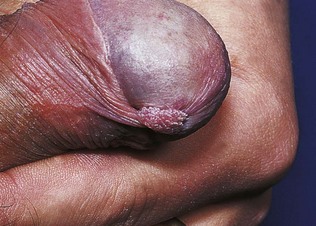21 Sexually transmitted infections
Introduction
There are two main principles in the management of sexually transmitted infections. First, an infected patient implies that at least one other person is also infected. Thus, treating a patient in isolation will not control the spread of these diseases. Second, a patient may harbour more than one sexually transmitted infection (Box 21.1). Many infections are asymptomatic, acquired months or even years previously. Patients are often uncomfortable or embarrassed to give their sexual history or a history of genitourinary symptoms as stigma and shame are often attached to sexually transmitted infections. Remember that babies, monogamous partners and victims of rape and sexual abuse can also be infected.
Box 21.1 Sexually transmitted/microbial agents in the genital tract (diseases)
Bacteria
 Neisseria gonorrhoeae (gonorrhoea)
Neisseria gonorrhoeae (gonorrhoea)
 Chlamydia trachomatis of D-K serovars (non-gonococcal urethritis)
Chlamydia trachomatis of D-K serovars (non-gonococcal urethritis)
 Chlamydia trachomatis of LGV 1-3 serovars (lymphogranuloma venereum)
Chlamydia trachomatis of LGV 1-3 serovars (lymphogranuloma venereum)
 Haemophilus ducreyi (chancroid)
Haemophilus ducreyi (chancroid)
 Mycoplasma genitalium (non-gonococcal urethritis)
Mycoplasma genitalium (non-gonococcal urethritis)
 Klebsiella granulomatis (donovanosis/granuloma inguinale)
Klebsiella granulomatis (donovanosis/granuloma inguinale)
 Gardnerella vaginalis, anaerobes, e.g. Mobiluncus, Bacteroides, Atopobium vaginae, Bacterial vaginosis associated bacteria 1-3, Leptotrichia, Sneathia species (bacterial vaginosis)
Gardnerella vaginalis, anaerobes, e.g. Mobiluncus, Bacteroides, Atopobium vaginae, Bacterial vaginosis associated bacteria 1-3, Leptotrichia, Sneathia species (bacterial vaginosis)
The interview and examination must be carried out in private, in strict confidence and avoiding any disapproving, judgemental or moralistic attitude. As with other clinical problems, diagnosis is achieved by history (Box 21.2), examination and relevant laboratory tests. Following diagnosis, effective treatment and partner notification/contact tracing should be instituted promptly. In children under 16 years of age, ensure they are able to comprehend (follow the Fraser’s guidelines in the UK) and it is essential to exclude any child protection issues and sexual abuse.
History
Presenting symptoms
Genital examination
Male genitalia
The penis
Note the appearance and size of the penis, the presence or absence of the prepuce and the position of the external urethral orifice. Examine the penile shaft for warts, molluscum, ulcers, burrows and excoriated papules of scabies and rashes. In Peyronie’s disease, there may be induration or a fibrotic lump inside the penile shaft. In the uncircumcised, establish that the prepuce can be readily retracted by gently withdrawing it over the glans penis. This allows inspection of the undersurface of the prepuce, the glans, the coronal sulcus and the external urethral orifice (meatus) for warts (Fig. 21.1), inflammation, ulcers and other rashes. Always carefully draw the prepuce forwards after examination; otherwise paraphimosis – painful oedema of the foreskin due to constriction by a retracted prepuce – may ensue.































